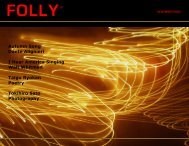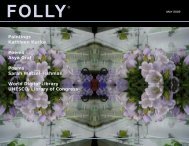1 Interdisciplinary Aesthetics Ivan Gaskell Is aesthetics a ... - Folly
1 Interdisciplinary Aesthetics Ivan Gaskell Is aesthetics a ... - Folly
1 Interdisciplinary Aesthetics Ivan Gaskell Is aesthetics a ... - Folly
Create successful ePaper yourself
Turn your PDF publications into a flip-book with our unique Google optimized e-Paper software.
I hope to have demonstrated, first, that <strong>aesthetics</strong> is always at the very least implicitly<br />
interdisciplinary, and, second, that in spite of being so one can pursue it from within<br />
philosophy, although in that case it would be greatly to the advantage of everyone<br />
interested in <strong>aesthetics</strong> to do so on a broad intellectual front. This is not to claim that<br />
everyone in <strong>aesthetics</strong> must master every pertinent contributory discipline: that would be<br />
unrealistic and absurd. Yet if the claims that philosophers make in the realm of <strong>aesthetics</strong><br />
are to find a wider audience, and thus to inform thought more generally, those claims<br />
must be plausible to practitioners of other disciplines who also make claims about the<br />
same or similar topics.<br />
For example, the later paintings of Piet Mondrian are amenable to discussion in terms<br />
of two-dimensional, rectilinear patterns, and anyone is free to discuss them as such. This<br />
may be one of their most interesting characteristics amenable to aesthetic consideration<br />
by philosophers. However, any such consideration that fails to take into account other<br />
characteristics of these paintings, such as their three-dimensionality, as manifested by<br />
their supports, layering of paints, revisions, surface facture, development of craquelure,<br />
may seem to be no more than a discussion of abstractions from the paintings—derivative<br />
artifacts, no less—rather than of the paintings themselves. 5 Such discussion is open to the<br />
suspicion that the selection of Mondrian’s patterns for consideration in isolation from<br />
their actual material embodiment, was made in ignorance of the possible roles—or even<br />
existence—of the neglected features, rather than as the result of informed choice. This is<br />
not to claim that the salient feature of these works for a particular aesthetic discussion<br />
5 For instance, compare John Brown, “Mondrian’s Balance” posted at<br />
http://www.philosophy.umd.edu/Faculty/jhbrown/mondriansbalance/index.html, with Ron Spronk,<br />
“Revealing Revisions: The Transatlantic Paintings in the Laboratory,” in Harry Cooper and Ron Spronk,<br />
Mondrian: The Transatlantic Paintings (Cambridge, MA: Harvard University Art Museums, and New<br />
Haven and London: Yale University Press, 2001), 67-106.<br />
7




